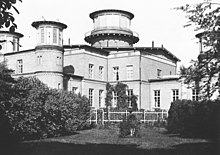Argelander Institute for Astronomy
The Argelander Institute for Astronomy (AIfA) at the University of Bonn was created in 2006 from the merger of three university institutes: the observatory , the radio astronomical institute , and the institute for astrophysics and extraterrestrial research .
Observatory
Astronomical research at the University of Bonn began immediately after the university was founded in 1817. The University's observatory on Poppelsdorfer Allee became famous around the world in the 19th century. The heads of the observatory were Karl Dietrich von Münchow (1819–1836), Friedrich Wilhelm August Argelander (1836–1875), Eduard Schönfeld (1875–1891), Karl Friedrich Küstner (1891–1924), Arnold Kohlschütter (1925–1946) and Friedrich Becker (1947–1966). The reconstruction of the university after the war and the rapid developments in astronomy led to various initiatives in Bonn under the leadership of Becker.
Hoher List Observatory
Like Küstner, Becker pursued the construction of an observatory as an outdoor station, free of urban light pollution. The summit Hoher List near Daun (Eifel) was selected as the location . Construction began in 1952 and in 1954 the astronomical work began there. In 1964 an extension followed, in particular with a 106 cm telescope, which was then large for a university institute. With the establishment of the European Southern Observatory at the end of the 1960s, with its large observatories on the La Silla mountains and later on Paranal (Chile), to which all German astronomers also have access, it had become difficult to obtain competitive quality measurement results on the Hohen List win. After many years of successful research, the decision was made in 2008 to cease operations on the Hohen List.
Radio astronomy
With the help of a ministerial director in Düsseldorf, an electronic receiver could be built after the war for the science of radio astronomy, which was used in 1956 on a so-called Würzburg giant (a 25 m radar mirror) on the Stockert near Bad Münstereifel. The successes in research led to the establishment of the Radio Astronomical Institute in 1957 . Soon the desire arose to be able to get involved internationally with a much larger radio telescope. The Max Planck Institute for Radio Astronomy (MPIfR) was founded in 1967 with the aim of building and realizing a large radio telescope . From 1997 on there was no more scientific work on the Stockert. The MPIfR's 100 m radio telescope in a valley near Effelsberg is still one of the best in the world.
Astrophysics and extraterrestrial research
When the first artificial satellite Sputnik was brought into orbit around the earth in 1957 , the guesswork began about the origin and meaning of the radio signals. Scientists in Bonn clarified the matter. In 1964 another institute of its own, the Institute for Astrophysics and Extraterrestrial Research , was established. Over the years, research into interplanetary space flourished and cosmological research intensified.
Merger
At Becker's request, the three now existing astronomical institutes [of the university] were merged into a department in 1964, the management of which was assigned to one of the three directors for two years. In 1965, the planning of a new institute building suggested by Becker began (he retired in 1966). Since 1973, the three university institutes have been based in a wing of the large new building for astronomy in the Endeich district of Bonn (the address Auf dem Hügel was and is beautiful for astronomers). The Max Planck Institute for Radio Astronomy uses around 2/3 of the building, the university institutes 1/3.
The three institutes of the university, which have maintained ever closer cooperation on the administrative level since moving into the building in Endenich, decided in 2006, with the benevolent approval of the university management, to merge into one institute. Argelander, who had given astronomy a rapid start in Bonn, was unanimously honored with the name for the whole thing.
literature
- Schmidt, H .: Astronomers of the Rheinische Friedrich-Wilhelms-Universität Bonn - their life and work 1819–1966 , Bouvier Verlag, Bonn (1990), ISBN 3416806042 .
Web links
- Literature from and about Argelander Institute for Astronomy in the bibliographic database WorldCat
- Homepage of the Argelander Institute for Astronomy (AIfA) at the University of Bonn

